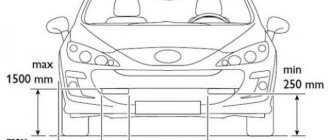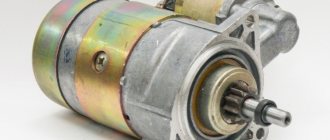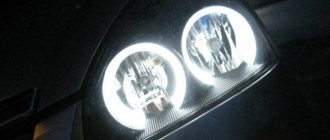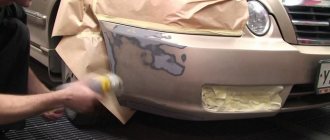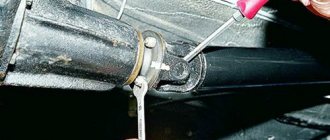LED strip angel eyes
Of course, the main disadvantage of the previous option is the large discreteness, which means the low brightness of the angel eyes. Of course, the number of diodes can be increased, but it should be taken into account that then the resistors will be located too close to each other and the LEDs, which increases the risk of overheating.
You can get rid of this drawback by using LED strip with a high density of LD elements. In addition to the tape, which can be purchased at lighting stores, we will need:
- sheet material 5-8 mm thick;
- blade used in hacksaws;
- opaque white film used as a diffuser;
- the so-called ballerina - a device for making large diameter holes;
- transparent adhesive composition;
- soldering equipment;
- special heat-resistant tape (polyamide or aluminum foil);
- heat-shrink tubing;
- a bundle of wires, preferably with terminals.
To begin, we mark the sheet of plexiglass, determining the outer and inner diameter of the ring placed on the headlight. We start cutting out from the outer contour, using a ballerina. In our case, an electric jigsaw cannot be used, since it leaves the edges of the cut melted, and we are not happy with this.
We cut out the inner contour of the circle in exactly the same way; it is not necessary to grind the outer end. Cover the top of the ring with light-scattering film. The same effect can be achieved by walking over the surface with medium-grade sandpaper - this will make it matte.
Now you can attach the LED strip to the glass base by first soldering the wires and insulating the soldering area with silicone sealant. You can cover the end of the circle with heat-resistant tape and check the operation of the circle by connecting the terminals to a 12 V power source. Angel eyes made from LED rings are ready!
Switching on through dimensions or low beam
The second version of the DRL connection diagram involves using the power circuit of the side light bulb. To do this, the positive wire from the running lights is directly connected to the “+” from the battery. In turn, the negative wire is connected to the “+” of the side light, which is currently electrically neutral. As a result, the following current flow path is formed: from the “+” of the battery through the LEDs to the size, and then through the light bulb to the body, which serves as the minus of the entire circuit. Due to the low current consumption (tens of mA), the LEDs begin to glow, and the lamp spiral remains extinguished.
This circuit solution has several disadvantages:
- running lights remain on when the engine is turned off, which is contrary to current regulations;
- the circuit will not work if LEDs are also installed in the dimensions;
- the circuit will not work correctly if the DRLs contain powerful SMD LEDs, the rated current of which is comparable to the current of a light bulb;
- For safety reasons, an additional fuse must be installed.
This connection method can be improved by connecting the positive wire of the LED module not to the “+” of the battery, but to the “+” of the ignition switch, thereby eliminating the first drawback.
Useful video
You can see some options for installing and connecting the DRL in the video below:
– these are lighting devices installed on a car and intended for use during daylight hours to improve the visibility of the vehicle while driving. DRLs can be provided by the manufacturer or installed additionally.
Daytime running lights on the VAZ-2114 are not provided by the manufacturer, therefore, if there is such a need, they can be installed additionally.
How to connect a voltage stabilizer (optional)
In the electrical on-board network of the car, the voltage “walks” from 12 to 16 volts. And LEDs do not tolerate such changes well. We soldered a resistor to each LED to regulate the voltage. But for more reliable protection you need a special stabilizer. It’s easier to buy a ready-made version and arrange it into a connection between the “angel eyes” and the on-board network of the car.
Factory version of the voltage stabilizer
If you are an “advanced” electrician, you can solder a simple stabilizer yourself. The L7812CV chip is used as a basis. See the photo below for the connection procedure.
The connection diagram is quite simple
According to this scheme, you need to connect the negative contact of the LED to the ground of the car, and the positive contact to the output of the stabilizer.
Video: connecting a voltage stabilizer for LEDs
The procedure for making and installing “angel eyes” is not easy. Before starting work, evaluate your abilities and capabilities to avoid possible additional costs. Consider whether your actions are legal and what consequences they may lead to. Neatness and cleanliness are required for successful completion of optics tuning. But everyone will notice your efforts.
Hello, dear friends! At one time, angel eyes on BMW cars made a splash on the market. It was optics of amazing beauty, especially in the dark. But even now fashion has not disappeared, and many people want to make angel eyes with their own hands.
In practice, there is nothing particularly complicated here. You will have to tinker, but the result will certainly please you. You can start from different instructions and manufacturing options. Some people use sites with videos that can be watched in parallel with taking notes in a notebook. Also on the Drive2 resource, motorists share their own experience of making peepholes, like those on a BMW.
I suggest you consider 3 interesting options. 2 of them are homemade and one more can be purchased online. The kit usually includes an ignition unit or a stabilizer, depending on the light source used.
Popular options for organizing daylighting in a car
After reading all of the above, some motorists may be upset. But in vain - there is a way out of this situation, because it is not necessary to use branded LED headlights. Light sources that you can install yourself, taking into account the technical tolerances of a certain car design, are quite suitable. There are many electrical circuits with which the system will be activated, including connection from a generator - everyone chooses their own option.
For example, you can make DRLs into standard headlights with your own hands from fog lights or at the place where their installation is planned. You don’t need permission to do this, all you have to do is connect the system as follows:
- When you turn the ignition key, the running lights turn on automatically.
- When the headlights are turned on, the running lights turn on, except in cases where the headlights are turned on briefly.
Budget ways to implement daylight lights
- LED running lights Eagle Eye HD-202b are mounted in standard PTF plugs.
- A flexible strip of LEDs secured around the fog lamp using double-sided tape.
- Installation of round lensed lamps in the places of standard PTF mounting.
- The use of an electronic relay to control the power of standard lamps, which allows them to be used as running lights.
The last option is quite simple to implement, so it is worth considering it in more detail.
Which angel eyes are better?
The question is ambiguous and difficult to answer. If you do not take into account manual assembly, then it is better to trust professionals who have already assembled similar headlights more than once. You can find a person who can make angel eyes to order very efficiently and quickly on any automotive forum or in social network groups dedicated to this topic.
It is recommended to contact people who have installed such lights themselves. They know how to select the right tubes, LEDs and take into account other nuances in order to achieve the maximum glow effect at minimal cost. In addition, they can show by their own example what the purchased angel eyes will look like.
Prefer to make your own headlights? Make sure to select a heat-resistant tube and LEDs with the appropriate light output. Angel eyes with a weak luminous flux will be practically invisible against the background of the main headlights. Very bright LEDs, on the contrary, will only blind oncoming vehicles and make it difficult for them to move on the road.
Angel eyes based on plexiglass rings
In order to make luminous rings for headlights or foglights using the first method, we will need:
Transparent rod can be purchased at a construction supermarket - these are used in blinds. Any can that matches the diameter of the reflector will be suitable as a cylinder. If the headlights are not round, then the process of bending the rod will be more difficult - you will have to make a template of a complex shape yourself from scrap material.
First, measure the circumference of the future ring. Then a piece of the rod of the required size is cut off, and holes for the LEDs are drilled in its ends. Now the rod can be bent.
To make the plexiglass soft, it is heated with a hair dryer. To make a ring, a softened rod is wrapped around a template and waited until it becomes hard again.
Now you can install the LEDs in the pre-drilled recesses at the ends. You can attach it using transparent glue. It is dripped into the recess and an LED is inserted.
For better dispersion on the resulting product, you need to make notches 0.5 mm deep at equal distances (the easiest way is to use a hacksaw blade or a needle file). In order not to suffer from painstaking work, you can cut a thread on a still straight rod using a die of suitable diameter.
Product advantages
Among the main advantages of DRLs with indicators, experts and car enthusiasts note:
- high energy efficiency;
- good lighting brightness (450 Lumens and above);
- the ability for flexible running lights to take absolutely any shape at the owner’s request;
- improving the appearance of your car;
- presence of 2 modes;
- the ability to install LED lamps not only inside the headlights, but also on other parts of the car;
- the ability to shorten LED products to the required length without losing their functionality;
- resistance to high and low temperatures, moisture, dust, vibration;
- use in a set as a repeater or separately from turn signals;
- long service life (up to 80 thousand hours).
Flexible daytime running lights Optima Flex DRL-9-60
This will allow you to catch the admiring glances of pedestrians and other motorists. The brightness of LEDs on the market can differ by two times, and their price also differs. You can install these products yourself, strictly following the instructions.
There are many options for installing DRLs on the front of the car. From my own experience, I can say that if you decide to really be more noticeable on the road, then you need to set it higher. If for you DRL is just an excuse for Mr. Traffic Policeman, then it doesn’t matter where you attach it.
Installing running lights at a car dealership when purchasing a new car is very expensive. They offered to install the Duster for 15 thousand rubles, the price of the Philips kit in the store is 3 thousand rubles. If the DRL is well equipped, installation and connection will take 15-20 minutes.
Abroad they are designated as DRL - an abbreviation for “Daytime Running Lights.”
- 1. Types of daytime running lights
- 2. Rules for installing navigation lights
- 3. Eye of the eagle
- 4. Modular models
- 5. DRL from fog lights
- 6. Some varieties for PTF
- 7. LED strip
- 8. LED neon tube
- 9. Video analysis of the headlight
- 10. DRL monoblock, classic
Does it make sense to install DRLs into standard car headlights yourself?
New traffic rules oblige drivers to operate vehicles during the daytime with low beam lights or daytime running lights turned on. The latter, of course, is preferable, but, unfortunately, this option is only available in cars released relatively recently. This is where all sorts of handmade ideas arise, especially since their advantages are quite objective:
- Organizing DRLs from the main beam with your own hands only requires modification in the form of connecting an electronic relay.
- Self-tuning is much cheaper than purchasing branded lighting fixtures.
- Extending lamp life.
- Reducing the load on the generator and saving fuel.
Let's not forget about the practical benefits - the car immediately becomes more noticeable, this is especially important when driving against the sun. Some lazy car enthusiasts may argue that low-beam headlights are quite suitable for the role of running lights, except that the dimensions and license plate lights will be on. And, you know, if we keep in mind the owners of “stale” models, then such thoughts are in a sense natural.
How to make angel eyes like a BMW
“Angel Eyes” is a unique horse from a German manufacturer, loved by so many motorists. However, if you like this mesmerizing glow, you don’t have to buy an expensive foreign car. This can be done on almost any car.
It is important that it has round front optics. For example, domestic VAZ 21213 or VAZ 2106 have it.
But, of course, the design will be even better suited to foreign cars, including the same old BMW models that so lack the shine of their successors
In any case, the beauty and effectiveness of the new headlight bezel may attract the attention of traffic police officers. But if they stop you on the road, it will be purely out of interest - the driver will not face a fine for this
How to properly connect DRL to a car?
In addition to installing and assembling the structure itself, you need to correctly connect everything to the electrical circuit of the car. The picture shows the simplest and most reliable DRL connection diagram. Let's take a closer look at it.
K1 is a relay with five contacts, one of the power contacts is normally closed, that is, it is closed when no current flows through the relay winding, and the other is normally open, it closes when current flows through the relay winding. This is one of the standard relays and is sold at any auto store.
Automotive relay, 12V
When you turn on the ignition, power is supplied to the DRL through the normally closed contacts, and when you turn on the low beam, the DRL relay is turned on from the power positive that goes to the lamps and the contacts open.
Making high-quality LED running lights for cars with your own hands is quite simple. They will surpass cheap Chinese crafts in quality and performance, and will work much longer.
Homemade DRLs will be cheaper than branded ones, and the experience gained is priceless.
Source
Getting ready for work
Plastic sticks
In order to decorate your vase (models from 2101 to 2115 and 21099), you will need to prepare a certain set of materials and tools.
To make “angel eyes” for a vase, you will need the following materials:
several plastic sticks. They must be equal in length to the dimensions of the optics on the machine. Therefore, to create tuning we will need four plastic sticks with a length of approximately 40-45 cm;
- heat-resistant sealant suitable for working with optics;
- four LED bulbs or strip. If using tape, give preference to the SMD 5050 model with 60 diodes per meter. The choice of LED glow color is determined only by your imagination. The best solution would be to match the color of the car with the color of the LEDs;
- four spare glasses for headlights. You need to buy them just in case, since it’s unlikely that you can remove the old ones intact and without chips;
- cable;
- resistors;
- 9 volt battery;
- a can or any round object that has the same diameter as the headlights;
- plexiglass with a sheet thickness of 10 mm.
The tools you will need are a glue gun, a hair dryer and pliers. You also need a drill with a set of drills and disk attachments.
Installation Requirements
Places for placing additionally installed DRLs are regulated by GOST and must meet the following requirements:
- the distance between the DRL lamps is at least 600 mm;
- from the edge of the body to the DRL - no more than 400 mm;
- the distance between the DRL and the road surface is at least 250 mm.
GOST R41.48-2004 requirements for installing DRLs on a car
As can be seen from this article, DRL for the VAZ-2114 can be independently selected and installed by each owner of this model, and this will not be difficult for him. This article and other information on the Internet will help in solving this problem.
"Angel eyes" and their color
Colors of “angel eyes”, and in what cases they can be installed on a car:
- yellow, red, green, orange, purple - allowed to be used as tuning on show cars;
- white, blue - can be used in everyday use, as lighting and dimensions.
In other words, the operation of “angel eyes”, other than white ones, does not comply with the rules governing the use of lighting devices. Their presence gives the traffic police the right to issue a fine, officially warn the driver, and be sure to confiscate non-standard lighting equipment. This ban also applies to multi-colored “angel eyes,” that is, to those whose color can change.
How to choose running lights
Installation of navigation lights according to GOST requires a special choice. If the car was purchased before the introduction of rules requiring the presence of daylight bulbs on the car, then you will have to face the task of collecting documents for permission to make changes to the design of the vehicle.
When choosing, consider the following:
- The lights must match the exterior and dimensions when mounted on the bumper.
- Each DRL must contain five bulbs with a power of 1 W (more bulbs will cause a strong glow, which will blind drivers of oncoming vehicles and attract the attention of traffic police officers).
- The influence of lighting should be in the range of 400–800 cd, and the temperature flux should be 4300–7000 K.
- Colored daytime lights are not installed; the glow must be white.
The most common and high-quality options for DRLs are from TM Osram, Philips, Hella.
Their design is developed according to standards; the kit includes a controller, connecting and fastening elements. When installing such components, there will be no problems during maintenance. Useful video on the topic:
A little about connection
In general, installation and connection largely depend on the specific vehicle and its design features. But some general and very important points are worth highlighting.
To begin with, elements such as angel eyes act as an additional lighting device as part of the vehicle. Therefore, their presence falls under the requirement for DRLs. As you understand, these are daytime running lights.
And according to the rules, they should be turned on simultaneously with starting the engine, and turned off when stopping. Plus, the DRLs are required to turn off when the headlights turn on. This tells us that the connection of the eyes should be carried out according to the connection diagram for daytime lights.
One of the options involves using 4 female terminals and one five-pin relay. The minus from the eyes goes to the body, and the plus goes to the relay.
Hi all. As promised, today I’ll tell you how to make “angel eyes”
at home, using available tools and materials. The article will be useful to those who love to make things with their own hands. Go!?
We all know what angel eyes are, and who owns (the chip belongs to BMW) this invention that is so popular with millions of motorists around the world. But, unfortunately, not everyone has the opportunity to buy a BMW, but they want to have beautiful tuned optics. What to do in this case? Everything is very simple, you need to “flex your brains” and make angel eyes with your own hands
To work you need to prepare:
- "Straight arms" :-). I’m joking, of course, but without the slightest experience in handmade crafts, you most likely won’t succeed... Therefore, before taking on this work, you need to realistically assess your own abilities.
- Plexiglas tubes (transparent PVC tubes). You can buy these online, at a hardware store, or at a decor store. Some craftsmen get creative and use strips of plexiglass or PVC as a plexiglass tube, which they cut into square strips, after which they are sanded into a round shape with sandpaper of different grain sizes. As an option, some use LED strip, but that’s a completely different story... I think someday I’ll tell you about this option for creating angel eyes.
- Soldering iron, four 12V resistors, bright LEDs rated at 3.5 volts. The color of the LEDs is at your discretion.
- A template or layout according to which the tube will be bent. The diameter of the template should match the diameter of the place where you are going to install the angel eyes. Here you can use anything: from a coffee can to a drainpipe of the required diameter...
- Electrical tape, heat shrink, soft copper wire. The length of the wire will be different for everyone, it all depends on the method of wiring and the location of the connection.
- Pliers, a household hair dryer, a metal blade or a special miniature cutting wheel for a screwdriver or drill.
- Sandpaper of different grains, file or needle file.
We perform the installation step by step
This guide explains how to install universal LED daytime running lights on any vehicle. Installation is quite simple, you just need to devote a little time to this procedure.
Step 1: Insert the wire into the bracket.
Let's start the installation procedure
Step 2: Install the bracket. Since these are versatile daylight lights, you can install them anywhere you like. The most common location is at the bottom of the bumper.
Most often they choose a place on the bumper
Step 3. After installing the bracket, you can fix the daytime running lights to the bracket.
Carefully attach the lantern
Step 4 . Once you install the DRL using the bracket, connect the wires and route them near the battery/fuse box.
We connect the wires
Step 5: Use plastic zip ties to secure the wire along the bumper. You can choose a different “wired path” if you wish.
Securely secure the wire using clamps
Step 6: Locate ACC on your fuse box, and press the red wire there. You can find the location of the ACC fuse using an electronic meter by clamping the black wire to the battery negative. Insert the tester pen into the fuse box in any unoccupied slot and note the places where the tester pen does not light up. Start the engine and check the slots that do not light up. Find a spot that only lights up when the engine is running. This is the ACC place.
Use a special search tester
Basically, when the engine is turned on, the indicator light comes on. When the engine is turned off, the indicator is also turned off.
Step 7: Once you have found the ACC location, you can press the red wire against the metal fuse plate and insert it back.
Slowly approaching the final stage
Step 8. Press the black wire to the negative of the battery.
Press the black wire to the negative terminal of the battery
Step 9: The pictures in the installation guide will help you follow this procedure with ease.
The result of the work done will pleasantly surprise you
Having information on how to install daytime running lights in accordance with all standards and requirements, you can save yourself from possible problems with traffic police representatives and increase the level of safety. Performing such “tuning” will have virtually no effect on the amount of fuel burned (consumption).
